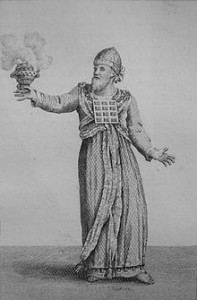Melchizedek: A Type of Christ
HEBREWS 7:1-3
NAS Hebrews 7:1-3 For this Melchizedek, king of Salem, priest of the Most High God, who met Abraham as he was returning from the slaughter of the kings and blessed him, 2 to whom also Abraham apportioned a tenth part of all the spoils, was first of all, by the translation of his name, king of righteousness, and then also king of Salem, which is king of peace. 3 Without father, without mother, without genealogy, having neither beginning of days nor end of life, but made like the Son of God, he abides a priest perpetually.
“EARLIER THE AUTHOR OF HEBREWS NOTIFIED HIS HEARERS THAT HE HAD A GREAT DEAL TO TELL THEM ABOUT MELCHIZEDEK…
NAS Hebrews 5:11 Concerning him we have much to say, and it is hard to explain, since you have become dull of hearing.
“HE NOW GETS TO THAT DIDACTIC TASK IN FULL EARNEST (5:12-6:20, therefore, form a parenthetical section leading up to chapter 7). He designs this unit of material as the groundwork for the following unit concerning the superiority of Christ’s Melchizedekian priesthood (7:11-28). But he first must draw the connection between Christ and Melchizedek a bit more firmly, which he does with an exposition of Genesis 14:17-20, the only Old Testament narrative we have on the enigmatic priest.” – Guthrie
NAS Genesis 14:17-20 Then after his return from the defeat of Chedorlaomer and the kings who were with him, the king of Sodom went out to meet him at the valley of Shaveh (that is, the King’s Valley). 18 And Melchizedek king of Salem brought out bread and wine; now he was a priest of God Most High. 19 And he blessed him and said, “Blessed be Abram of God Most High, Possessor of heaven and earth; 20 And blessed be God Most High, Who has delivered your enemies into your hand.” And he gave him a tenth of all.
THERE IS ONLY ONE OTHER PASSAGE IN THE OLD TESTAMENT WHERE WE FIND ANYTHING WRITTEN ABOUT MELCHIZEDEK…
NAS Psalm 110:1-7 A Psalm of David . The LORD says to my Lord: “Sit at My right hand, Until I make Thine enemies a footstool for Thy feet.” 2 The LORD will stretch forth Thy strong scepter from Zion, saying, “Rule in the midst of Thine enemies.” 3 Thy people will volunteer freely in the day of Thy power; In holy array, from the womb of the dawn, Thy youth are to Thee as the dew. 4 The LORD has sworn and will not change His mind, “Thou art a priest forever According to the order of Melchizedek.” 5 The Lord is at Thy right hand; He will shatter kings in the day of His wrath. 6 He will judge among the nations, He will fill them with corpses, He will shatter the chief men over a broad country. 7 He will drink from the brook by the wayside; Therefore He will lift up His head.
HEBREWS IS THE ONLY BOOK IN THE NEW TESTAMENT THAT MENTIONS MELCHIZEDEK! For such an important personage, I believe you will agree, that is at the least surprising
JOHN MACARTHUR HAS CALLED CHAPTER 7 “THE FOCAL POINT OF HEBREWS.” “It concerns the central, the most important, part of Judaism – the priesthood. No sacrifices could be made except by the priest and no forgiveness of sins could be had apart from the sacrifices. Obedience to the law was exceedingly important, but the offering of sacrifices was even more important. And the priesthood was essential for offering them. Consequently, the priesthood was exalted in Judaism.”
HOWEVER MY EXTENDED BLOG ON HEBREWS MAY EVENTUALLY TURN OUT IN TERMS OF A DECISION ON THE APPLICATION OF THE NEW COVENANT, I BEGAN TO BE DRAWN TO THE POSSIBILITY OF IT INCLUDING THE CHURCH TODAY SOME THIRTY YEARS AGO WHEN I FIRST HEARD A LEARNED PASTOR OVER THE RADIO SAY WITH IMPRESSIVE ASSURANCE THAT IT DID NOT. Essentially, the Christian world is and has been for centuries, divided over the interpretation of Jeremiah 31:31 and Old Testament passages associated with it, which we will look into in detail in future blogs Basically the key question is whether or not the “old covenant,” mainly referring to the Jeremiah verse, is meant for the New Testament church today. Again basically, in the simplest terms, some, such as covenantalists, believe that it does; some, such as exegetes who take the Bible strictly literally and place heavy emphasis on the importance of the original language to proper interpretation – some might say the exorbitant attention to same, do not, or least question it.
NAS Jeremiah 31:31 “Behold, days are coming,” declares the LORD, “when I will make a new covenant with the house of Israel and with the house of Judah,
AT THAT EARLY TIME OF MY CHRISTIAN EXPERIENCE I CANNOT SAY I POSSESSED EVEN A BASIC KNOWLEDGE OF THE QUESTION ITSELF, let alone the question’s far-reaching theological ramifications. Thanks be to God, I’ve learned a lot about the question and its complexities since then, but time, unfortunately, has not brought me to a point of resolution. Hopefully, this study will finally do it. But if it doesn’t, I know the time and effort will be much more than worthwhile.
THIS SAID, I COULD HAVE RIGHTLY TITLED THIS BLOG “THE NEW COVENANT – PART 1,” for this is the actual beginning (I have already written several blogs that have dealt directly or indirectly with the New Covenant) of the heart of the Hebrews’ discussion of the New Covenant (the term “new covenant” does not require capitalization for any literal or grammatical reasons; I have simply chosen to do so for purposes of emphasis).…
THE ALL-ENCOMPASSING SUBJECT OF CHAPTERS 7 AND 8 IS THE NEW COVENANT.
“THE WRITER HAS ALREADY INTRODUCED THE SUBJECT BY IMPLICATION EARLIER IN THE EPISTLE, BUT IT IS ONLY NOW THAT HE LAUNCHES UNTO A FILL EXPOSITION OF THIS, ITS CENTRAL THEME.
“HE ARGUES POWERFULLY THAT A NEW PRIESTHOOD (NAMELY THE MELCHIZEDIAN PRIESTHOOD) SIGNALS A NEW COVENANT. YOU CANNOT GRAFT CHRIST’S HIGH PRIESTHOOD ON TO THAT OF THE MOSAIC ORDER. NOR CAN THE MOSAIC PRIESTHOOD SURVIVE THE ‘BETTER COVENANT’ IN CHRIST’S ATONING BLOOD. THERE IS A NEW COVENANT AND A NEW PRIESTHOOD, AND FORMER THINGS HAVE PASSED AWAY.” – Andrews
I THINK OF THE OLD COVENANT BEING LIKE AN OLD WALKMAN AND THE NEW COVENANT BEING LIKE A MODERN i-PAD. They’re similar but they’re simply not the same. The latter is obviously better in everyway. They not compatible. The Walkman is obsolete. “Former things have passed away.”
“IN VERSES 1-10 OF CHAPTER 7, THE WRITER EMPHASIZES THE ‘OTHERNESS’ AND TRANSCENDENCE OF CHRIST’S PRIESTHOOD BY TRACING IT BACK TO THE PRIESTLY ORDER OF MELCHIZEDEK. This Old Testament character is thus established as a ‘TYPE’ of Christ – especially in respect of His priestly and kingly offices and His eternal existence. THE TYPOLOGY IS RICH WITH SIGNIFICANCE, FOR IT ESTABLISHES MORE FIRMLY THAN EVER THAT CHRIST ALONE PROVIDES THE SINNER WITH RIGHTEOUSNESS AND PEACE. – Andrews
MELCHIZEDEK IS A TYPE OF CHRIST. I BELIEVE THAT IS THE MOST ACCURATE AND RESPONSIBLE ANSWER TO THE QUESTION OF WHO IS MELCHIZEDEK?
WHAT EXACTLY IS A TYPE? “In biblical study, a type refers to an Old Testament person, practice, or ceremony that has a counterpart, an antitype, in the New Testament. In that sense types are predictive (TYPES ARE A FORM OF PROPHECY – TAR). The type pictures, or prefigure, the antitype. The type, though it is historical, real, and of God; is nonetheless imperfect and temporary. The antitype, on the other hand, is perfect and eternal. The study of types and antitypes is called, as one might expect, typology.
“THE BRONZE SERPENT that God commanded to set on a standard, for example, was a type of Christ’s being lifted up on the cross…
NAS Numbers 21:8 Then the LORD said to Moses, “Make a fiery serpent, and set it on a standard; and it shall come about, that everyone who is bitten, when he looks at it, he shall live.”
NAS John 3:14 “And as Moses lifted up the serpent in the wilderness, even so must the Son of Man be lifted up;
“THE SACRIFICIAL LAMB was a type of the Lamb of God, Jesus Christ, who was sacrificed for the sins of the world (Genesis 14, Psalm 110, and Hebrews 5-7. THE MOST DETAILED INFORMATION IS IN HEBREWS 7:1-3.
“TYPES ARE FRAIL ILLUSTRATIONS AT BEST.
“TYPES ARE ANALOGIE’S, and, like all analogies, they correspond to the person or thing to which they are compared only in certain ways – perhaps only in one way.
“SO, WHO EXACTLY IS MELCHIZEDEK? There is much conjecture about Melchizedek. Some insist he is an angel who took human form for a while during the time of Abraham. But the priesthood was a human, not angelic, function (Heb. 5:1). Others suggest that He is actually, not just typically, Jesus Christ Himself, who took a preincarnate form during Abraham’s time. But Melchizedek is described in Hebrews 7 as ‘made’ like the Son of God (7:3), not as being the Son of God. I believe that Melchizedek was a historical human being, whose priestly ministry typifies that of Christ, a man whom God designed to use as a picture of Jesus Christ. But WE CANNOT BE SURE OF THE DETAILS OF HIS IDENTITY. Those remain among the secret things that belong only to the Lord.” – MacArthur
I AGREE WITH MACARTHUR. I believe the Bible supports this view as being the most accurate one for the Christian to take.
– Professor Thomas A. Rohm



